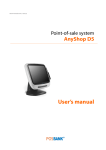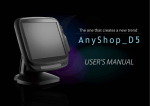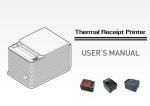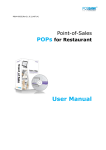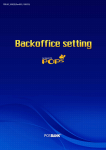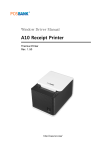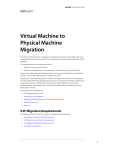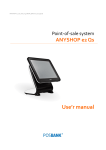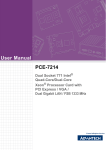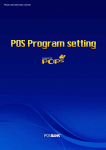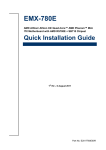Download AnyShop Eco User Manual Rev004
Transcript
PBUM-017E(Rev004;130530) Point-of-sale system AnyShop Eco User’s manual -Table of ContentsCOPYRIGHT ................................................................................................................................................................................................................................... 3 WARRANTY ................................................................................................................................................................................................................................... 4 POSBANK USER’S MANUAL REVISION HISTORY.................................................................................................................................................................. 5 PREFACE ......................................................................................................................................................................................................................................... 6 SYMBOL; MARK ........................................................................................................................................................................................................................... 7 SAFETY INSTRUCTIONS ............................................................................................................................................................................................................ 8 NOTICE ........................................................................................................................................................................................................................................... 9 LIABILITY LIMITATION ............................................................................................................................................................................................................ 10 INSTALLATION RECOMMENDATIONS .............................................................................................................................................................................. 11 1.PRODUCTOVERVIEW...................................................................................................................................................................... 12 (1) INSIDE YOUR PACKAGE ................................................................................................................................................................................................................................ 12 (2) PRE-INSTALLATION PREPARATION ........................................................................................................................................................................................................... 14 (3) PRODUCT OUTLINE ....................................................................................................................................................................................................................................... 14 (4) CONFIGURATION ............................................................................................................................................................................................................................................ 15 (5) INSTALLATION OF OPTIONAL DEVICES: CDP INSTALLATION ........................................................................................................................................................ 18 (6) INSTALLATION OF OPTIONAL DEVICES: 2ND DISPLAY INSTALLATION ...................................................................................................................................... 19 (7) SETTING UP: KEYBOARD & MOUSE CONNECTION ............................................................................................................................................................................ 22 (8) SETTING UP: CONNECTION USB PORT ................................................................................................................................................................................................... 23 (9) SETTING UP: CONNECTION VIA ETHERNET PORT (LAN) .................................................................................................................................................................. 24 (10) SETTING UP: LINE-OUT, MIC-IN, LINE-IN CONNECTION ................................................................................................................................................................. 25 (11) SETTING UP: PRINTER CONNECTION .................................................................................................................................................................................................... 26 (12) SETTING UP: POWER CABLE CONNECTION ....................................................................................................................................................................................... 27 (13) SWITCHING ON POS.................................................................................................................................................................................................................................... 28 (14) SHUTTING DOWN POS .............................................................................................................................................................................................................................. 29 (15) SYSTEM DRIVERS .......................................................................................................................................................................................................................................... 30 2.MOTHERBOARD ............................................................................................................................................................................ 31 (1) MOTHERBOARD OVERVIEW ....................................................................................................................................................................................................................... 31 (2) MOTHERBOARD LAYOUT............................................................................................................................................................................................................................. 32 (3) SIDE USB BOARD ............................................................................................................................................................................................................................................ 34 (4) POWER SWITCH BOARD............................................................................................................................................................................................................................... 35 (5) DRAWER KICKER BOARD.............................................................................................................................................................................................................................. 36 (6) DRAWER PORT BOARD ................................................................................................................................................................................................................................. 37 (7) JUMPERS ............................................................................................................................................................................................................................................................ 38 3.BIOSSETUPUTILITY......................................................................................................................................................................... 41 (1) MANAGING AND UPDATING YOUR BIOS .............................................................................................................................................................................................. 41 (2) BIOS SETUP PROGRAM................................................................................................................................................................................................................................. 42 (3) MAIN SETUP...................................................................................................................................................................................................................................................... 44 4.TROUBLESHOOTING ....................................................................................................................................................................... 63 (1) NETWORK ISSUES ........................................................................................................................................................................................................................................... 63 (2) MSR ISSUES ....................................................................................................................................................................................................................................................... 63 (3) USB ISSUES........................................................................................................................................................................................................................................................ 63 (4) LCD ISSUES........................................................................................................................................................................................................................................................ 63 (5) TOUCH-SCREEN ISSUES................................................................................................................................................................................................................................ 64 (6) POWER ISSUES................................................................................................................................................................................................................................................. 64 (7) PS/2 KEYBOARD ISSUES ............................................................................................................................................................................................................................... 64 (8) BOOTING ISSUES............................................................................................................................................................................................................................................. 64 5.MAINTENANCE .............................................................................................................................................................................. 65 ANYSHOP ECO MODULE POS SYSTEM REPLACEMENT............................................................................................................................................................ 66 (1) DETACHING MAIN UNIT ............................................................................................................................................................................................................................... 66 (2) SEPARATING MSR MODULE ........................................................................................................................................................................................................................ 68 (3) HDD REPLACEMENT ...................................................................................................................................................................................................................................... 69 (4) MOTHERBOARD REPLACEMENT ............................................................................................................................................................................................................... 70 SPECIFICATION ............................................................................................................................................................................ 72 2 Copyright This publication, including all photographs, illustrations and software, is protected under international copyright law with all rights reserved to the manufacturer. Neither this manual, nor any of the material contained herein, may be reproduced without express written consent of the author. AnyShop and POSBANK are trademarks of POSBANK Co., Ltd. in the United States and other countries. * Other names and brands may be claimed as the property of others. Copyright© POSBANK Co., Ltd. All rights reserved. 3 Warranty We guarantee our POS terminal product and its parts against defects in materials and workmanship, under proper use, for a standard period of 2 years from the original date of purchase. During this period, we will repair or replace defective and/or faulty products or parts without charge to the customer for parts and labor. The 1st year includes servicing and new or refurbished replacement parts free of charge, with one-way shipping costs borne by the seller. The customer shall, however, be responsible for the return delivery costs. The 2nd year also includes free of charge servicing and parts, but a limited warranty requires the entire shipping cost to be borne by the customer. Products out of the warranty period or scope shall be diagnosed at the customer's expense. In the case of product damage due to error on part of the consumer, incorrect usage, carelessness or natural phenomenon, the customer shall bear the full cost for both repair and delivery. 4 POSBANK User’s manual Revision History Changes to the AnyShop Eco User’s manual are listed below. Rev No. Revision History Date /author PBUM-017E(Rev001;120131) New 2012.01.31 PBUM-017E(Rev002;120717) Modify 2012.07.17 PBUM-017E(Rev003;121011) Separating add. / spec modify 2012.10.11 PBUM-017E(Rev004;130530) Separating add. / spec modify 2013.05.30 5 Preface This User's Guide gives information about main unit/IO port layout, basic setup, component installation, and board layout for point of sale system "AnyShop Eco" Intended Audience The User's Guide is intended for technically qualified personnel. It is not intended for general audiences. Document Organization The chapters in this Product User’s manual are arranged as follows: 1. 2. 3. 4. 5. 6. product package contents system configuration Harness (cable connector) BIOS Setup Installing and Replacing POS SYSTEM Components: instructions on how to install the motherboard and other POS hardware components. Product specification 6 SYMBOL; MARK CE MARK This device complies with the requirements of the EEC directive 2004/108/EC with regard to “Electromagnetic compatibility” and 2006/95/EC “Low Voltage Directive”. FCC This device complies with part 15 of the FCC rules. Operation is subject to the following two conditions: (1) This device may not cause harmful interference. (2) This device must accept any interference received, including interference that may cause undesired operation. KC Korea Certification mark. Certificate No. KCC-REM-PBS-AnyShopEco(A) Recycling and disposal of electric and electronic devices and their components This product should not be mixed with other commercial wastes for disposal. 7 Safety Instructions 1. To disconnect the machine from the electrical power supply, turn off the power switch and remove the power cord plug from the wall socket. 2. The wall socket must be easily accessible and in close proximity to the machine. 3. Read these instructions carefully. Save these instructions for future reference. 4. Follow all warnings and instructions marked on the product. 5. Do not use this product near water. 6. Do not place this product on an unstable cart, stand, or table. The product may fall, causing serious damage to the product. 7. Slots and openings in the cabinet and the back or bottom are provided for ventilation to ensure reliable operation of the product and to protect it from overheating. These openings must not be blocked or covered. 8. The openings should never be blocked by placing the product on a bed, sofa, rug, or other similar surface. 9. This product should never be placed near or over a radiator or heat register or in a built-in installation unless proper ventilation is provided. 10. Never push objects of any kind into this product through cabinet slots as they may touch dangerous voltage points or short out parts that could result in a fire or electric shock. Never spill liquid of any kind on the product. 8 Notice 1. 2. 3. 4. 5. 6. 7. 8. 9. Always ensure that the correct power voltage is used as a precaution against fire and electrical shock. Avoid exposing product to direct sunlight. Do not use product in areas of high humidity. Doing so may cause low reliability and/or operational malfunction. Be careful of static electricity on PCB of system with anti-static appliances. Doing so may cause inferior reliability and shorted product life. Keep product away from highly static areas. This may lead to inferior performance and reduced life cycle. Do not interfere with, or obstruct metal components inside product. Doing so may cause the risk of fire or electric shock. Do not pull on power cable or peripheral devices’ connector cable. Doing so may cause fire, electric shock or electronic system malfunction. Use caution when around other electronic devices with possible high frequency or electro-magnetic effects e.g. Audio, Electronic-range etc. Doing so will lead to the serious risk of product malfunctioning or a system error occurring. Ensure that batteries are replaced correctly. Failure to do this may result in sudden explosions. Dispose of used batteries properly according to the instructions. 9 Liability Limitation ● Installation and maintenance We recommend that you inquire about product installation, maintenance and repair service from the official service center and agent office. POSBANK takes no responsibility for malfunctions or system errors occurring after service and/or system check carried out by unofficial service providers. ● High frequency appliances This product is qualified by FCC, CE and KC compliances, and is thus governed by these qualifications’ safety regulations. However, the product can affect and be affected by other high frequencies generated around it. As such, POSBANK does not consider liability for any system error or disorder due to this issue. ● Electronic noise emitting equipment We recommend using the product away from electronic noise emitting equipment such as heaters, motors, fluorescent lights, TVs etc. as it may cause interruption or interference with normal operation. ● Installation location For optimal performance, the product should be kept in an environment of lower than 65% humidity and in a temperature of 10 ~ 30℃. Please also keep away from direct sun-light. ● Cleaning procedure Cleaning with chemical based products (in particular those containing benzyl or chemical thinning agents) can damage the exterior surfaces of the product. We recommend using a soft damp cloth and wiping gently, taking particular care when dealing with the LCD display screen. ● Product limitations 1. The use of this product for anything other than POS tasks is strictly prohibited. The product is not supported for regular PC and interface operation. 2. This product is for business use only, and not for usage in the home. 3. Both hardware and software are both fully configured. 4. Normal operating is guaranteed on a steady power connection. 10 Installation Recommendations 1. 2. 3. 4. 5. 6. 7. Avoid installing during thunderstorms. (Possibility of dangerous exposure to electricity.) Install away from damp spaces or water-leaks. Beware of static occurrence during installation. Use only ground connected and quality certified power cords and cables. Keep out of direct sun-light, extremely high or low temperatures, or high humidity areas. Install product away from areas prone to shocks or vibration. Install product away from sewing machines, welding equipment, electric stoves, audio equipment and other high frequency generating equipment. 8. Installation and use in close proximity to an air-conditioning unit is not recommended. 9. Do not connect cables underneath carpets or floorboards. 10. Only use power cables supplied by pre-approved and certified venders. 11. Never use power cords from high power source appliances. e.g. Electronic heaters, Electric stoves, Audio equipment, Air-conditioners, Refrigerators etc. 12. The use of multiple connections in a shared power outlet/socket is not recommended. 11 1. Product Overview (1) Inside Your Package 1. 2. Please check your package and confirm its contents. The POS terminal main unit, power cable, user manual and driver CD are included in the package. If any items are missing or damaged, please contact your dealer for assistance. » All user manuals and drivers are available for download on our website: www.posbank.com/www.easyset.org AnyShop Eco Main unit Adapter / Power cord Installation guide Drivers CD 12 Optional Devices: 12 inch LCD monitor” 13 Optional Devices: Customer Display (CDP) Optional Devices: CDP (Customer display) (2) Pre-installation Preparation 1. 2. Remove protective film from touch-screen to prevent possible operating difficulties. Attach all optional parts before setting up the main POS unit. (3) Product Outline • • Each part of product may differ depending on the specific POS model. Model-specific data sheets are provided on our website at www.easyset.org 14 (4) Configuration Refer to following diagram to identify the components on this side of the system. Front view 15 1 6 1 5 7 2 2 3 4 7 1. 2. 3. 4. 5. 6. 7. LCD & Touch panel display Power LED HDD LED LAN LED Magnetic stripe reader(MSR); Option Smart card reader(SCR); Option Power switch Rear view 3 4 1 1 2 1. 2. 3. 4. 5. USB port I/O port Customer display (CDP) - optional HDD Stand 5 16 Standard I/O port 17 1 2 (5) Installation of Optional Devices: CDP Installation * Warning: Completely remove AC power cable when opening main unit or installing optional devices. CDP Installation 18 Step 1. Insert (-) driver in the grooves marked: and detach cover from rear of main unit. Step 2. Connect to the main unit using the CDP-cable and insert the display in customer display space. Step 3. Testing: CDP is successfully installed when system boots after powering on. (CDP and 12 inch LCD monitor are used only with the COM4 port.) (6) Installation of Optional Devices: 2nd Display Installation * Warning: Completely remove AC power cable when opening main unit or installing optional devices. 12 inch LCD Monitor 19 Step 1. Remove both screws as shown above and remove cover. Step 2. Replace standard cover with “Optional Cover” and reinsert screws. 12 inch LCD Monitor 20 Step 3. Use 2nd display cable to connect monitor to main unit. Step 4. Place monitor into frame and insert the 4 screws as shown. Step 5. Use the 2 remaining screws to secure the unit, and finally replace the cover. 12 inch LCD Monitor 21 Step 6. Testing: CDP is successfully installed when system boots after powering on. (CDP and 12 inch LCD Monitor are used only with COM4 port.) (7) Setting up: Keyboard & Mouse Connection Connecting the keyboard and mouse to the PS/2 port on the bottom panel. or connecting the USB type keyboard and mouse to the USB port on the bottom panel. 22 (8) Setting up: Connection USB Port Four USB ports are provided in the POS unit, two at the rear I/O and two at the side, all of which support the standard USB 2.0. Some USB devices (optional devices) are only functional with specific driver software installed. If multiple USB devices are used together, this may result in abnormal functionality. Using a USB hub with external adapter for supplying power is recommended. Dependent on the type of device, it is possible for the USB device to be recognized later than normal. 23 (9) Setting up: Connection via Ethernet Port (LAN) The Ethernet port located at the rear I/O supports 10/100/1000Mbps using an RJ45 connector cable. When connected properly, the LAN LED light will be switched on.. 24 LINK/ACT LED SPEED LED LINK / ACT LED SPEED LED Status OFF YELLOW BLINKING Status OFF ORANGE GREEN Description No link Linked Data activity Description 10Mbps connection 100Mbps connection 1Gbps connection (10) Setting up: Line-out, Mic-in, Line-in connection • • • Line In port (light blue): This port connects a tape, CD, DVD player, Sources. Line Out port (lime): This port connects a headphone or a speaker.In4-channel, 6-channel and 8channel configuration, the function of this port becomes Front Speaker Out. Microphone port (pink): This port connects a microphone. 25 (11) Setting up: Printer Connection Connect printer cable to either Serial or USB port as required. 26 (12) Setting up: Power Cable Connection Insert power cable into power connector socket. 27 CAUTION : Do not pull on the adaptor cable! Disconnect cable with pulling the plug cap. (13) Switching On POS The power switch is located right hand side of the speaker. When connected to AC source, the POWER LED will be lighted-on automatically. The unit's status can be determined by each LED lamp. Indicator modes are as follows; 28 1. 2. 3. AC input OK : POWER LED is lit (Green) Operation mode : HDD LED is blinking (Red) When connected LAN : LAN LED is blinking (Yellow) (14) Shutting Down POS * For product stability, we recommend closing Windows from the O/S. Please make sure that you have closed all applications before closing Windows. 1. 2. Click ‘Start’ and select ‘Turn off Computer’ Click ‘Shut Down’ to close Windows. 29 (ex: POSReady2009 or Windows XP) 2 1 (15) System Drivers Please visit our website: www.posbank.com for the latest driver updates. Supported devices: Cash drawer, CDP (Customer Display Panel), MSR (Magnetic Swipe Reader) and printer. Driver installation ● Installation method : Driver will automatically install by clicking SETUP.EXE in your driver CD. If you require any help with installing or using our OPOS system, please contact our customer service center. ● Folder of contents of POS terminal installation driver: 1. CHIP SET DRV installation 2. VIDEO (VGA) DRV installation 3. TOUCH DRV installation 4. AUDIO DRV installation method 5. LAN DRV installations 6. AMT & ME Driver installation 7. User’s Manual, Installation guide 30 2. Motherboard (1) Motherboard Overview This includes description of the jumpers and connectors on the motherboard. Warring Take note of the following precautions before you install motherboard components or change any motherboard settings. 1. Unplug the power cord from the wall socket before touching any component. 2. Before handling components, use a grounded wrist strap or touch a safely grounded object or a metal object, such as the power supply case, to avoid damaging them due to static electricity. 3. Hold components by the edges to avoid touching the ICs on them. 4. Whenever you uninstall any component, place it on a grounded antistatic pad or in the bag that came with the component. 5. Before you install or remove any component, ensure that the ATX power 6. Supply is switched off or the power cord is detached from the power supply. Failure to do so may cause 31 (2) Motherboard Layout This includes description of the jumpers and connectors on the motherboard. Motherboard view 32 NO Description 1. SATA_PWR_CN2 2. SATA 2 3. SATA 1 4. SATA_PWR_CN1 5. J1 6. J2 7. Mini PCIe slot 8. COM 6 9. COM 5 10. JCOMPWR2 11. JCOMPWR3 12. JCOMPWR1 13. COMPSEL5 14. CN15 15. COMPSEL4 15-1. JAMP1 16. COM 4 16-1. COMPSEL6 NO Description 17. 18. 19. 20. 21. 22. 23. 24. 25. 26. 27. 28. 29. SYS_FAN CPU_FAN COMPSEL3 VGA 1 LVDS1 CN29(12V DC) CN30(24V DC) COMP1SEL2 COMP1SEL1 VP1(Inverter) F-Panel1 GPIO1 CMOS1 33 (3) Side USB Board Side USB Board Connector Description 34 A A. To Motherboard USB (4) Power Switch Board Power Switch Board Connector Description 35 A A. Power switch (5) Drawer Kicker Board Drawer Kicker Board Connector Description B 36 C A A. Drawer Port B. Serial Port C. Mini PCIe Slot (6) Drawer Port Board Drawer Port Board Connector Description 37 B A A. From Drawer Kicker B. Cash Drawer port (7) Jumpers Clear RTC RAM (CLRTC) This jumper allows you to clear the Real Time Clock (RTC) RAM in CMOS. You can clear the CMOS memory of date, time, and system setup parameters by erasing the CMOSRTC RAM data. The onboard button cell battery powers the RAM data in CMOS, which include system setup information such as system passwords. To erase the RTC RAM: 1. Turn OFF the computer and unplug the power cord. 2. Remove the onboard battery. 3. Move the jumper cap from pins 1-2 (default) to pins 2-3. Keep the cap on pins 2-3 for about 5~10 seconds, then move the cap back to pins 1-2. 4. Re-install the battery. 5. Plug the power cord and turn ON the computer. 6. Hold down the <Del> key during the boot process and enter BIOS setup tore-enter data. CAUTION: Except when clearing the RTC RAM, never remove the cap on CLRTC jumper default position. Removing the cap will cause system boot failure! Clear RTC RAM (CLRTC) 1 11 23 1. Clear RTC RAM (CLRTC) 2. Normal(Default) 3. Clear CMOS #_You do not need to clear the RTC when the system hangs due to overclocking. For system failure due to over clocking, use the C.P.R. (CPU Parameter Recall) feature. Shut down and reboot the system so the BIOS can automatically reset parameter settings to default values. 38 COM1, 2, 3, 4, 6RI, +12V and +5V Power Select(COMP1SELx) This jumper allows you to select COM1 RI, +5V and +12V power. Set COMP1SELx top ins 5-6 +5V power. And set COMP1SELx to pins 1-2 +12V power. Then setCOMP1SELx to pins 3-4 for RI selection. COMP1SELx 39 1 5 3 4 1 1 1 1. 2. 3. 4. 5. 6. COMP1SEL1 COMP1SEL2 COMP1SEL5 COMP1SEL4 +12V +5V 2 6 COM5RS232, RS422, RS485 Select(JCOMPWRx) This jumper allows you to select COM5 RS232, RS422, RS485. Changing jumpers will beselected different RSxxx protocols. JCOMPWRx 40 RS232 (Default) RS422RS485 JCOMPWR1 1 2 3 JCOMPWR2 JCOMPWR3 1. JCOMPWR2 2. JCOMPWR3 3. JCOMPWR1 #_This jumper allows you to select COM5 RS232, RS422, RS485. Changing jumpers will beselected different RSxxx protocols. 3. BIOS Setup Utility * This chapter tells how to change the system settings through the BIOS Setup menus. Detailed descriptions of the BIOS parameters are also provided. (1) Managing and updating your BIOS 1.1 Creating a bootable floppy disk 1. Do either one of the following to create a bootable floppy disk. DOS environment a. Insert a 1.44MB floppy disk into the drive. b. At the DOS prompt, type Format A:/S then press <Enter>. Windows® XP environment a. Insert a 1.44 MB floppy disk to the floppy disk drive. b. Click Start from the Windows® desktop, then select My Computer. c. Select the 3 1/2 Floppy Drive icon. d. Click File from the menu, then select Format. A Format 3 1/2 Floppy Disk window appears. e. Select Create an MS-DOS startup disk from the format options field, then clickStart. Windows® 2000 environment To create a set of boot disks for Windows® 2000: a. Insert a formatted, high density 1.44 MB floppy disk into the drive. b. Insert the Windows® 2000 CD to the optical drive. c. Click Start, then select Run. d. From the Open field, type D:\bootdisk\makeboot a: assuming that D: is your optical drive. e. Press <Enter>, then follow screen instructions to continue. 2. Copy the original or the latest motherboard BIOS file to the bootable floppydisk. 41 (2) BIOS setup program This motherboard supports a programmable firmware chip that you can update using the provided utility described in section “2.1 Managing and updating your BIOS.” Use the BIOS Setup program when you are installing a motherboard, reconfiguring your system, or prompted to “Run Setup”. This section explains how to configure your system using this utility. Even if you are not prompted to use the Setup program, you can change the configuration of your computer in the future. For example, you can enable the security password feature or change the power management settings. This requires you to reconfigure your system using the BIOS Setup program so that the computer can recognize these changes and record them in the CMOS RAM of the firmware hub. The firmware hub on the motherboard stores the Setup utility. When you start up the computer, the system provides you with the opportunity to run this program. Press <Del> during the Power-On-Self-Test (POST) to enter the Setup utility; otherwise, POST continues with its test routines. If you wish to enter Setup after POST, restart the system by pressing <Ctrl+Alt+Delete>, or by pressing the reset button on the system chassis. You can also restart by turning the system off and then back on. Do this last option only if the first two failed. The Setup program is designed to make it as easy to use as possible. Being a menu-driven program, it lets you scroll through the various sub-menus and make your selections from the available options using the navigation keys. • The default BIOS settings for this motherboard apply for most conditions to ensure optimum performance. If the system becomes unstable after changing any BIOS settings, load the default settings to ensure system compatibility and stability. Select the Load Default Settings item under the Exit Menu. See section “2.7 Exit Menu.” • The BIOS setup screens shown in this section are for reference purposes only, and may not exactly match what you see on your screen. 2.1 Legend Box The keys in the legend bar allow you to navigate through the various setup menus. Key(s) Function Description F1 General help, only for Status Page Setup Menu and Option Page Setup Menu Esc Return to the main menu from a sub-menu or prompts you to quit the setup program ←,→ Move to the item in the left or right hand ↑,↓ Move to previous or next item Enter Brings up a selection menu for the highlighted field + or PgUp Moves the cursor to the first field - or PgDn Moves the cursor to the last field F5 F6, F7 F10 Loads the previous values Loads the fail-safe / optimized defaults Saves changes and exits Setup 42 2.2 List Box This box appears only in the opening screen. The box displays an initial list of configurable items in the menu you selected. 2.3 Sub-menu Note that a right pointer symbol () appears to the left of certain fields. This pointer indicates that you can display a sub-menu from this field. A sub-menu contains additional options for a field parameter. To display a sub-menu, move the highlight to the field and press <Enter>. The sub-menu appears. Use the legend keys to enter valuesand move from field to field within a sub-menu as you would within a menu. Use the <Esc> key to return to the main menu. Take some time to familiarize yourself with the legend keys and their corresponding functions. Practicenavigating through the various menus and submenus. If you accidentally make unwanted changes to any of the fields, press <F6> to load the fail-safe default values. While moving around through the Setup program, note that explanations appear in the Item Specific Help window located to the right of each menu. This window displays the help text for the currently highlighted field. 43 (3) Main Setup 3.1Main Menu Press<Del> to enter AMIBIOSCMOS Setup Utility, the Main Menu will appear on the screen. Use arrow keys to select among the items and press <Enter> to accept orenter the sub-menu. 44 The Main BIOS setup screen has two main frames. The left frame displays all the options that can be configured. Grayed-out options can not be configured ; options in blue can. The right frame displays the key legend. Above the key legend is an area reserved for a text message. When an option Is selected in the left frame, it is high lighted in white. Often a text message will accom-pany it. •System time / System date Use this option to change the system time and date. Highlight System Time or System Date using the <Arrow> keys. Enter new values through the keyboard. Press the <Tab> key or the <Arrow> keys to move between fields. The date must be entered In MM/ DD/ YY format. The time must be entered in HH:MM:SS or mat. 3.2Advanced BIOS Features Select the Advanced tab from the AIMB-2l2 setup screen to enter the BIOS Setup screen. You can select any of the items in the left frame of the screen, such as CPU Configuration, to go to the submenu for that item. You can display an Advanced BIOS Setup option by highlighting it using the<Arrow>keys. All Advanced BIOS Setup options are described in this section. The Advanced BIOS Setup screen is shown below. The submenus are described on the following pages. 45 3.3CPU Configuration 46 •Max CPUID Value Limit This item allows you to limit CPUID maximum value. •Execute-Disable Bit Capability This item allows you to enable or disable the No-Execution page protection technology. •Hyper Threading Technology This item allows you to enable or disable Intel Hyper Threading technology. •Intel® Speed StepTMtech When set to disabled, the CPU run satits default speed, when set to enabled, the CPU speed is controlled by the operating system. •Intel® C-STATE tech This item allows the CPU to save more power run deride mode. •Enhanced C-States CPU idle set to enhanced C-States, disabled by Intel®. C-STATE tech item. 3.4IDE configuration 47 •ATA / IDE Configuration This can be configured as Disabled, Compatible or Enhanced. •Configure SATA as This can be configured as IDE or AHCI. •SATAI/SATA2 While entering setup,the BIOS automatically detects the presence of SATA devices. This displays the status of SATA device auto-detection. •IDE Detect Time Out (Sec) This item allows you to select the time out value for detecting ATA/ ATAPI device(s). •AHCI Configuration AHCI is a new interface specification that allows the SATA controller driver to support advanced features. While entering setup, BIOS auto detects the AHCI devices. This displays the status of auto detection of AHCI devices. 48 •On board Serial port1 [3F8/IRQ4] This item allows user to adjust serial port1 address and IRQ. •On board Serial port2 [2F8/IRQ3] This item allows user to adjust serial port2 address and IRQ. •On board Serial port3 [C80/IRQII] This item allows user to adjust serial port3 address and IRQ. •On board Serial port4 [C88/IRQI0] This item allows user to adjust serial port4 address and IRQ. •On board Serial port5 [C90/IRQII] This item allows user to adjust serial port5 address and IRQ. •On board Serial port6 [C98/IRQI0] This item allows user to adjust serial port7 address and IRQ. 3.5Hardware Health Configuration 49 •CPU warning temperature Use this to set the CPU warning temperature threshold. When the system CPU reaches the warning temperature ,the buzzer will beep. 3.6General ACPI Configuration 50 •Suspend mode Select the ACPI state used for system suspend. •Report Video on S3 Resume This item allows you to invoke VABIOSPOST on S3 / STR resume. 3.7Advanced ACPI Configuration 51 •ACPI Version Features This item allows you to enable RSDP pointers to 64-bit fixed system description tables. •ACPIAPIC support Include ACPI table pointer to RSDT pointer list. •AMI OEMB table Include OEMB table pointer to R(x)SDT pointer lists. •Head less mode Enable/ Disable Head less operation mode through ACPI. 3.8APM Configuration 52 •Power Management/ APM Enable or disable APM power management function. •Restore on AC Power Loss This option allows user to set system action when AC power restores after AC Power loss. Available options include Power Off, Power On, Last Status. •Resume On Ring Disable / Enable RI wake event. •Resume On RTC Alarm Disable / Enable RTC wake event. 3.9USB Configuration 53 •Legacy USB Support Enables support for legacy USB. Auto option disables legacy support If no USB Devices are connected. •USB2.0 Controller Mode This item allows you to select Hi-Speed (48OMbps) or Full Speed(l2Mpbs). •BIOS EHCI Hand-Off This is a workaround for Oss without EHCI hand-off support. The EHCI owner-ship change should be claimed by EHCI driver. 3.10Advanced PCI/ PnP Settings Select the PCI / PnP tab from the AIMB-2l2 setup screen to enter the Plug andPlay BIOS Setup screen. You can display a Plug and Play BIOS Setup option by highlighting it using the <Arrow> keys. All Plug and Play BIOS Setup options are described in this section. The Plug and Play BIOS Setup screen is shown below. 54 •Clear NVRAM Set this value to force the BIOS to clear the Non-Volatile Random Access Memory (NVRAM). The Optimal and Fail-Safe default setting is No. •Plug& Play O/S When set to No, BIOS configures all the devices in the system. When set to Yes and if you install a Plug and Play operating system, the operating system configures the Plug and Play devices not required for bootup. •PCI Latency Timer Value in units of PCI clocks for PCI device latency timer register. •Allocate IRQ to PC IVGA When set to Yes, will assign IRQ to PCI VGA card if card requests IRQ. When set to No will not assign IRQ to PC IVGA card even if card requests an IRQ. •Palette Snooping This item is designed to solve problems caused by some non-standard VGA card. •PCI IDE Bus Master When set to enabled, BIOS uses PCI bus mastering for reading! Writing to IDE drives. •Off Board PCI / ISA IDE Card Some PCI IDE cards may require this to be set to the PCI slot number that is holding the card. Set to Auto works for most PC/IDE cards. •IRQ 3/ 4/ 5/ 7/ 9/ 10/11 This item allows your respectively as sign an interrupt types for IRQ-3, 4, 5, 7, 9, 10,11. •DMA Channel 0/1/3/5/6/7 When set to Available, will specify DMA is available to be used by PCI/PnP devices. When set to Reserved, will specified DMA is Reserved for use by legacy ISA devices. •Reserved Memory Size This item allows you to reserve a set amount of memory for legacy ISA devices. 55 3.11Boot settings Configuration 56 •Quick Boot This item allows BIOS to skip certain tests while booting. This will decrease the time needed to boot the system. •Quiet Boot If this option is set to Disabled,the BIOS displays normal POST messages. If Enabled, an OEM Logo is shown instead of POST messages. •Boot up Num-Lock Select the Power-on state for Numlock. •Wait For .F1. If Error Wait for the F1 key to be pressed if an error occurs. 3.12 Security Setup 57 Select Security Setup from the PCM-9562 Setup main BIOS setup menu. All Security Setup options, such as pass word protect ion and virus protection are described in this section. To access the sub menu for the following items, select the item and press <Enter> : •Change Supervisor / User Password Provides for either installing or changing the password. 3.13Advanced Chipset Settings 58 •North Bridge Configuration •South Bridge Configuration 3.14 North Bridge Chipset Configuration 59 •DRAM Frequency This item allows you to manually change DRAM frequency. •Configure DRAM Timing by SPD This item allows you to enable or disable detect by DRAM SPD. •Initiate Graphic Adapter This item allows you to select which graphics controller to use as the primary boot device. •Internal Graphics Mode Select Select the amount of system memory used by the Internal graphics device. 3.15 Video Function Configuration 60 •DVMT Mode Select Displays the active system memory mode. •DVMT / FIXED Memory Specifies the amount of DVMT/ FIXED system memory to allocate for video memory. •Boot Display Device Select boot display device at post stage. •Flat Panel Type This item allows you to select which panel resolution you want. 3.16 South Bridge Chipset Configuration 61 •USB Functions Select : Disabled, 2 USB Ports, 4USB Ports, 6USB Ports or 8USB Ports. •USB 2.0 Controller Enables or disables the USB2.O controller. •LAN controller Enables or disables the GbE controller. •SLP_S4 # Min. Assertion Width This item allows you to set a delay of a set number of seconds. 3.17 Exit Option 62 •Save Changes and Exit When you have completed system configuration, select this option to you’re your changes, exit BIOS setup and reboot the computer so the new system configuration parameters can take effect. Select Save Changes and Exit from the Exit menu and press <Enter>. The following message appears: Save Configuration Changes and Exit Now? [Ok] / [Cancel] 2.Select Ok or Cancel. •Discard Changes and Exit Select this option to quit Setup without making any permanent changes to the system configuration. Select Discard Changes and Exit from the Exit menu and press <Enter>. The following message appears: Discard Changes and Exit Setup Now? [Ok]/ [Cancel] 2.Select Ok to discard changes and exit. •Discard Changes l.Select Discard Changes from the Exit menu and press<Enter>. •Load Optimal Defaults The ID525-PBP3 automatically configures all setup items to optimal settings when you select this option. Optimal Defaults are designed for maximum system performance, but may not work best for all computer applications. In particular, do not use the Optimal. Defaults if your computer is experiencing system configuration problems. Select Load Optimal Defaults from the Exit menu and press <Enter>. 4.Troubleshooting (1) Network Issues Symptom Corrective Procedure Cannot access LAN ▪ Check if hub or switch is working correctly ▪ Check RJ45 cable connection ▪ Check if LAN LEDs are on/off ▪ Reinstall LAN card ▪ Replace motherboard (2) MSR Issues Symptom Corrective Procedure MSR does not respond ▪ Check MSR reader cable connection ▪ Check motherboard and LCD cable connection ▪ Check MSR board cable connection (3) USB Issues Symptom Corrective Procedure USB port doesn’t work ▪ Check Windows device manager for device recognition ▪ Check USB device status and connection ▪ Erase and re-install USB driver ▪ Change USB device (4) LCD Issues Symptom Corrective Procedure LCD backlight doesn’t work ▪ Check LCD cable connection ▪ Check inverter cable connection ▪ Replace inverter cable ▪ Change LCD panel 63 (5) Touch-screen Issues Symptom Corrective Procedure Touch-screen doesn’t detect touch operations ▪ Check touch-screen cable connection ▪ Check motherboard and LCD cable connection ▪ Check BIOS set-up (6) Power Issues Symptom Corrective Procedure System switches off abruptly and system does not load ▪ Check A/C cable connection ▪ Check motherboard power connection ▪ Check CPU settings/status ▪ Check DRAM settings ▪ Check power button cable connection ▪ Change power adaptor unit (7) PS/2 Keyboard Issues Symptom Corrective Procedure PS/2 Keyboard Issues ▪ Check card-reader cable ▪ Check CN6 jumper (8) Booting Issues Symptom Corrective Procedure Re-booting during system operation ▪ Check SATA cable connection ▪ Check memory status 64 5. Maintenance Safety Warning POSBANK will not be held responsible for repairs conducted via service providers other than those officially specified by the seller. General Guidelines 1. 2. 3. 4. 5. Always disconnect the unit from the power outlet. Disconnect all cables from the POS main unit before attempting reparation. Keep all components in the static-proof packaging provided until ready for installation. If the device still is not functioning after repair, please turn off the POS unit and contact the customer service center for a follow-up inspection. We recommend that power supply unit (PSU) checks and monitor repairs only be performed at a certified service center. 65 AnyShop Eco Module POS System Replacement (1) Detaching Main Unit Main Unit 66 Step 1. Remove the 2 screws as shown above and take off cover. Step 2. Remove the 8 screws from the frame under the cover. Main Unit 67 Step 3. Detach main unit from stand. Step 4. Main unit is now detached. (2) Separating MSR module MSR Installation 68 Step 1. Remove dummy cover at the rear left of the main unit. » PS2, USB and Serial port connections are supported Step 2. Connect MSR cable to MSR unit. Step 3. Affix MSR to main unit using 2 screws as shown. (3) HDD Replacement HDD Replacement 69 Step 1. Remove HDD cover from main unit. Step 2. Press down as shown and HDD will be ejected. Step 3. Insert new HDD and replace cover. (4) Motherboard Replacement Motherboard Replacement 70 » We recommend removing MSR, HDD and CDP before replacing the motherboard. Step 1. Remove the 8 screws on reverse side of main unit using a (+) driver and take off the rear cover. Rear cover is now removed Motherboard Replacement 71 Step 2. Next, remove the last 4 screws as shown above. Step 3. Remove cable from motherboard. Motherboard is now removed. Step 4. Replace with new motherboard and reassemble unit using the reverse procedure of steps 1-6 as shown previously. Specification AnyShop Eco CPU Intel Atom processor D525 (1M Cache, 1.8 GHz, Dual Core for Pineview D) Chipset Intel ICH8M Storage SATA HDD 2.5inch (Default 320GB), SSD is available by option Memory DDR3-800MHz SODIMM 2GB (MAX. 4GB) VGA Integrated Intel Gen3.5+GFX Render Core 400MHz (Pineview-D) Display 15" TFT-LCD 300 cd/㎡ (1024 x 768 resolution) 5-wired Resistive Touch Screen Internal I/O USB 3 Ports (reserved for touch controller, SCR EMV card, MSR controller) RS-232 COM 4 reserved for CDP COM 5 & 6 with 9pin header VGA Reserved for 2nd display Extension Mini PCIe LVDS 24bit LVDS External I/O USB Rear 2, Side 2 PS/2 Mouse 1 / Keyboard 1 RS-232 COM 1 ~ 3 with +5/12V power output on 9pin LAN Realtek RTL 8111E Gigabit LAN VGA Reserved for 2nd display (Shared with internal 15pin header) Audio ALC 892 GR / Rear panel out(jack): Line-out, Mic-in, Line-in Options MSR Comply with ISO 7811, Support 1 & 2 & 3 track SCR EMV level 1 Dallas Dallas I-button reader Customer display VFD type (20 x 2) 2nd LCD 10.1" LCD or 12.1" LCD (1024 x 768 resolution) WiFi Mini PCIe for wireless LAN Operating Temperature 0 ℃ ~ 40 ℃ at 10% ~ 80% humidity Storage Temperature -20 ℃ ~ 60 ℃ at 10% ~ 80% humidity Qualification CE, FCC, KC Power 12V / 5A Adaptor OS Support Windows XP/XPE/7, WEPOS, POS Ready 2009/7 Dimension (W x H x D) 385 x 395 x 265(mm) * Product specifications may differ according to location and may be changed without prior notice. *MSR is supported USB interface only 72








































































